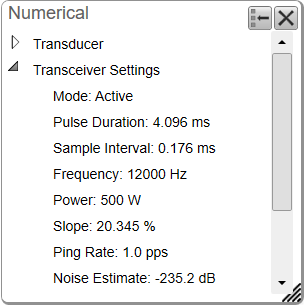Description
The following information is provided in the Transceiver list. Some of the settings are specific for echo sounder or ADCP operation.
|
• |
Mode: The operating mode is controlled by Operation on the Operation menu. You can set it to Normal, Replay or Inactive. To activate the Advanced Sequencing operating mode an operational sequence must have been created previously. The current operating mode is also shown in the Extras menu. |
|
• |
Pulse Duration: The Pulse Duration setting specifies the current duration ("length") of the transmitted pulse. You can manually select a pulse duration that suits your operation. This setting is controlled in the Normal Operation dialog box. The current setting of this parameter is also shown in the Extras menu. |
|
• |
Sample Interval: The information from the transducer on the EK80 system is a continuous flow of analogue data. In signal processing, sampling is the reduction of this continuous signal to a discrete signal. We convert a sound wave (which is an analogue continuous-time signal) to a sequence of samples (which is a discrete-time signal). The sample rate is the average number of samples obtained in one second. The sample interval is 1/sample rate to allow readout in time (normally milliseconds). |
|
• |
Frequency: This setting is controlled in the Normal Operation dialog box. The Start Frequency and End Frequency parameters are used to set up a frequency sweep ("chirp"). If the parameters for start and end frequencies are unavailable, the transducer used on the relevant channel does not support
wide band transmissions. In order to use the frequency sweep ("chirp") functionality, you must use frequency modulated pulses. You must also use a transducer that supports the frequency range. |
|
• |
Power: The Power parameter in the Normal Operation dialog box displays the transmitter's output power measured in Watts. You can change the output power manually. Output power is limited either to the maximum rating of the transducer, or the maximum rating of the transmitter, whichever
is the smallest. |
|
• |
Slope: The Slope value identifies how fast the output power in each transmission ("ping") goes from 0 to maximum. The value (in %) indicates the amount of the pulse duration that is spent during this increase. For example, if the Slope value is 50%, it means that half the duration of the "ping" is spent building up the power to maximum. |
|
• |
Ping rate: The phrase ping rate is used to describe the parameter that controls how often the EK80 system can or shall transmit acoustic energy (a "ping") into the water. The ping rate is normally limited by the maximum range settings. It also depends on hardware limitations. This may be, for example, how fast your EK80 system can handle the information from each ping, how fast it communicates with external peripherals, or how long time it
uses to save data. The ping interval (1/ping repetition frequency (PRF)) is the ping rate measured in time between each acoustic transmission. |
